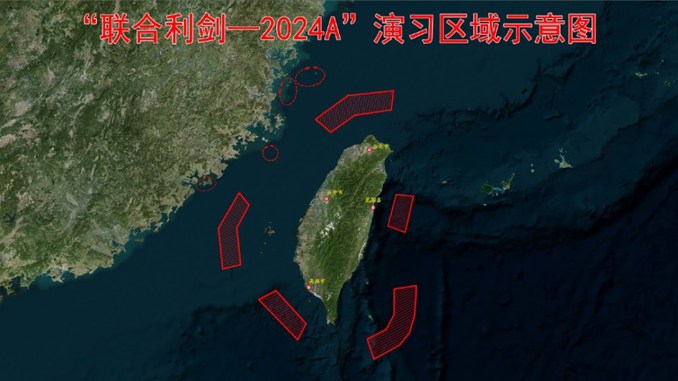
China considers the islands of great strategic value, connecting Taiwan via sea and air links, as early warning features that can alert Taipei of advancing forces.
Reminiscent of the angry and unprecedented, first-of-their-kind live-fire drills around Taiwan in August 2022 following the visit of former US Speaker Nancy Pelosi, China commenced simultaneous massive drills at six locations around the island.
Chinese observers quoted in Global Times have identified the exercises by their code name, Joint Sword-2024A. Chinese officials have officially blamed new President Lai Ching-te for “provoking” the drills by his “secessionist” speech on May 20, 2024.
The latest exercises by the ETC (Eastern Theater Command), for the first time encompass the Taiwan-controlled islands of Dongyin, Matsu, Wuqiu and Kinmen.
Taiwan too dispatched fighters, warships and anti-ship missiles to observe and deter the Chinese maneuvers.
A notable feature was the deployment of what observers claimed was the HF-3 (Hsiung Feng-III) supersonic anti-ship cruise missile, developed by the National Chung-Shan Institute of Science and Technology (NCIST).
WATCH: Dozens of warplanes, multiple destroyers and frigates of the PLA Eastern Theater Command are encircling the island of Taiwan and its outlying islands, conducting mock strikes in the ongoing Joint Sword-2024A exercise. https://t.co/V1LeGXu5MM pic.twitter.com/A4xjNRhvQv
— Global Times (@globaltimesnews) May 23, 2024
Chinese Weapons, Drills
The PLA Eastern Theater Command also released a set of posters themed “Cross-Straits Lethality,” depicting some of its weaponry. These comprised the J-20 stealth fighter, the J-16 multirole jet, the Type 052D destroyer, the Type 071 comprehensive landing ship, the DF-16A short-range ballistic missile, and the modularized long-range multiple launch rocket system. Global Times quoted an unidentified Beijing-based military expert who laid out how the weapons would be used.
China PLA Eastern Theater Command published a video introducing six weapons of “cross strait lethality”.https://t.co/nPuaW9qFau pic.twitter.com/dRBGvtzgXa
— Ryan Chan 陳家翹 (@ryankakiuchan) May 23, 2024
The J-20 can take advantage of its stealth capability and break down hostile air defenses; the J-16 can drop a large number of munitions on ground targets; the Type 052D can seize control and block maritime access to the island; while the Type 071 can carry heavily equipped landing troops to cross the Straits; the DF-16A can conduct precision strikes on high-value military and political targets; and the modularized long-range multiple launch rocket system can ensure artillery fire superiority at a relatively low cost.
Taiwanese Response
Taiwan’s Military News Agency released footage of a truck-mounted missile, operated by the RoCN (Republic of China Navy) calling it a “missile vehicle maneuvering to a tactical position.” Some defense and war analysis handles identified it as the HF-III.
「#海軍 #海鋒大隊 飛彈車機動前往戰術位置。」(中華民國海軍提供)
Follow @mna_roc ,為您帶來第一線國軍戰備實況!#ROCArmedForce #ROCNavy #ProtectOurCountry #ROC #Taiwan🇹🇼 pic.twitter.com/XvhrPulH21
— 軍聞社 Military News Agency, ROC(Taiwan)🇹🇼 (@mna_roc) May 23, 2024
The RoC’s Ministry of National Defense said “detected 1 PLA aircraft, 8 PLAN vessels, and 4 CCG vessels operating around Taiwan” by early morning on May 23. The aircraft entered Taiwan’s Southwest and Southeast ADIZ.
1 PLA aircraft, 8 PLAN vessels, and 4 CCG vessels operating around Taiwan were detected up until 6 a.m. (UTC+8) today. The aircraft entered Taiwan’s SW and SE ADIZ. #ROCArmedForces have monitored the situation and responded accordingly. pic.twitter.com/2dOXPzOfVJ
— 國防部 Ministry of National Defense, R.O.C. 🇹🇼 (@MoNDefense) May 23, 2024
It also released footage of its F-16 Vipers, F-CK-1 Ching-kuo, AH-64 Apaches, and warships, among other platforms. undertaking patrols and sorties in response to the Chinese exercises.
In the face of PLA pressure, our service members stand vigilant. #ROCArmedForces are prepared. We seek no conflicts, but we will not shy away from one to ensure our nation’s safety and protect our beautiful homeland. pic.twitter.com/Qye4qLXDpz
— 國防部 Ministry of National Defense, R.O.C. 🇹🇼 (@MoNDefense) May 23, 2024
The Hsiung Feng II and III missiles are the Republic of China (RoC) Navy’s most advanced and the mainstay of their anti-shipping arsenal. In mid-September 2023, the RoCN conducted an exercise involving the HF-II, HF-III, and a US-made Harpoon anti-ship missile (AShM), where videos showed them hitting target vessels. Pictures showed three holes punched in the retired warship used for target practice.
Early in July, Taiwan’s Ministry of National Defense (MND) announced hiking production of its homegrown AShM platforms, according to a report in the Taipei Times, which includes the HF-III, an extended-range variant of the HF-II.
According to Taiwan News, the MND is also attempting to modify the HF-III to be fired from the F-CK-1, by removing its two boosters and downsizing the missile. F-CK-1 possesses “flight speeds” with the “initial velocity for launching the missiles.” However, the missile is rather heavy, at 1,500 kilograms, while the IDF can carry a maximum payload of 4,000 kg.
Surrounding Taiwanese Islands – A First
Chinese media considers the islands of great strategic value, connecting Taiwan via sea and air links, as early warning features that can alert Taipei of advancing forces. Since last year, the PLAN (People’s Liberation Army Navy) had also begun exercising off the western seaboard of Taiwan too.
The drills that began at 7:45 am on May 23, are designed to “surround” Taiwan from “both the east and the west,” across “all directions without any blind spots,” forming a situation where the island is pinned down from both sides. The command released a map of the exercises, depicting the exercise zones. Senior Captain Li Xi, a spokesperson of the ETC, said that the army, navy, air force and rocket force were involved in the drills.
The islands were meanwhile covered by the China Coast Guard (CCG), that launched a “comprehensive law enforcement exercise” around Wuqiu and Dongyin islands to test its “joint patrol, rapid reaction and emergency response capabilities.”
The Fujian Coast Guard 14606 flotilla circled around Wuqiu, coming as close as 2.8 nautical miles to Dawuqiu and three nautical miles to Xiaowuqiu. Meanwhile, in the direction of Dongyin island, the 14607 flotilla came as close as 3.2 nautical miles to Dongyin island. It is the first time the mainland’s coast guard vessels have entered waters around Wuqiu and Dongyin islands.
Wuqiu and Dongyin islands are outlying islands of the main island of Taiwan, with “high strategic and military value.” They “oversee key transportation routes” in the Taiwan Strait and are a “crucial point” for implementing “multiple layers of deterrence.”
Exhaustive Chinese Preparations
PLAN and PLA Air Force (PLAAF) aircraft had meanwhile begun breaching the imaginary “Median Line” that vertically splits the Taiwan Strait into half, beside their routine ingress into the island’s ADIZ (Air Defense Identification Zone). Officially released material by the Chinese military, therefore show comprehensive exercises covering all aspects of a military takeover, high-altitude reconnaissance, unmanned surveillance-strike, naval encirclement, blockade, long-range sea, surface and air-launched anti-land missile strikes, amphibious landing and urban warfare.
This validates a long-held assessment that a Chinese military move on Taiwan will involve a sudden, large, overwhelming, multifront, combined arms, complete encirclement of the island, presenting a fait accompli to Taipei’s leadership. In theory, the democratic government is expected to calculate that military resistance before the massively outsized PLA would be futile.
An invasion would therefore possibly be a fluid extension of the routine provocative exercises, which by now normalized, would be hard to differentiate as an actual military move.
The only unpredictable ‘X’ factor could be a heavy urban battle, if the Taiwanese resistance decides to dig in. Regardless of the exhaustiveness of the Chinese preparation, it would be politically costly not only for Beijing, but for Taiwan’s ruling Democratic People’s Party (DPP) too. There are indications in China’s economic and diplomatic dealings with Taiwan that it would avoid an urban war like Gaza and that its military move would be aimed at frightening Taipei into formally acceding to the mainland.
- SEO Powered Content & PR Distribution. Get Amplified Today.
- PlatoData.Network Vertical Generative Ai. Empower Yourself. Access Here.
- PlatoAiStream. Web3 Intelligence. Knowledge Amplified. Access Here.
- PlatoESG. Carbon, CleanTech, Energy, Environment, Solar, Waste Management. Access Here.
- PlatoHealth. Biotech and Clinical Trials Intelligence. Access Here.
- Source: https://theaviationist.com/2024/05/23/chinese-drills-around-taiwan/?utm_source=rss&utm_medium=rss&utm_campaign=chinese-drills-around-taiwan




